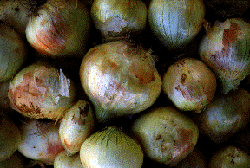NuMex Dulce

NuMex Dulce was developed by Joe Corgan and Marisa Wall of the department of Agronomy and Horticulture at NMSU, supported by the New Mexico Dry Onion Commission and the New Mexico Agricultural Experiment Station. NuMex Dulce is a low pungency, short-day, yellow grano-type onion that matures from late May to early June when fall planted in southern New Mexico. It has excellent yield, pink root resistance and bolting resistance, similar to NuMex Starlite. However, bulbs of NuMex Dulce are lower and more uniform in pungency than those of NuMex Starlite.
NuMex Dulce is a low pungency selection from NuMex Starlite. NuMex Starlite was derived from five cycles of mass selection from Texas Grano 502 PRR. In developing NuMex Dulce, the first selection for low pungency was made in June 1990. Prior to pungency analysis, field selections were made for uniform maturity, bulb shape, and pink root resistance. Selections were made for uniformity of maturity during late May to early June when fall-seeded. Selected bulbs were slightly top-shaped and of medium depth. Selection for pink root resistance was accomplished by growing populations in soil severely infested with Phoma terrestris E.M. Hans., the causal agent for pink root, and selecting only bulbs with less than 20% pink roots. (The picture above is of NuMex Dulce (99).)
Selected bulbs were taken to the laboratory for pungency evaluation using the pyruvic acid (PA) technique. Pyruvic acid is a by-product of the metabolic reactions that result in onion pungency. Low PA production, from the action of the alliinase enzyme, is correlated with low pungency. Taste panels rate onions with PA levels less than 4.5 µg fresh mass (FM) as mild. To breed for low pungency, only bulbs with PA levels of 4.0 µg FM or lower were used. Bulbs were evaluated for single centers by cutting each bulb transversely. Any bulb with one or two growing points within the center diameter of 3.5 cm was considered as single centered.
Selected bulbs from NuMex Starlite were intercrossed, and the seed was collected individually from each bulb in 1991. The population was designated as 91-1 and consisted of maternal half-sib progeny lines. Seed of these lines were planted in Fall 1991 for bulb production. A second selection cycle in the field (for maturity, pink root resistance, and shape) and laboratory (for low pungency and single-centers) was made among and within half-sib progeny lines of 91-1 in June 1992. Selected bulbs were planted and the plants intercrossed in an isolation cage to produce 93-17 seed. Replicated field trials were conducted in Las Cruces, N.M. in 1994 and 1995 comparing 93-17 (NuMex Dulce) with NuMex Starlite. Based on those results, the line 93-17 was released as NuMex Dulce in 1995.
NuMex Dulce is a short-day, yellow grano-type onion with an estimated adaptation range of 28 to 32 degrees latitude. Bulbs are slightly top-shaped with pale yellow, thin outer scales and white interior. NuMex Dulce produces large bulbs and foliage, the latter being medium green with a light bloom. NuMex Dulce is recommended for fall seeding or spring transplanting to provide a supply of low pungency onions during the month of June. Suggested planting dates at Las Cruces, N.M. are October 1-10. NuMex Dulce also performs well when transplanted during February. Late maturity (June 15-25) can be obtained by transplanting about March 1.
NuMex Dulce and NuMex Starlite were evaluated in replicated field trials in 1994, 1995, and 1996. All data were subjected to analysis of variance for a randomized complete block design with five blocks. In the laboratory, 10 bulbs of each cultivar were analyzed from each block (total of 50) for pungency, and 20 bulbs per block were cut to evaluate the percentage of single centers. NuMex Dulce bulbs harvested in 1994 and 1995 were not significantly different from NuMex Starlite bulbs for percent bolting, percentage of marketable bulbs, percentage of single centers, average bulb mass, maturity, or yield. The average pungency for NuMex Dulce bulbs in the three field trials in 1994 and 1995 was 4.65 µg FM compared with 5.45 µg FM for NuMex Starlite bulbs, a relatively large difference. The pungency of NuMex Dulce bulbs was significantly lower (PÛ 0.05) than that of NuMex Starlite bulbs in two of the three trials. In the trial seeded August 30, 1994, differences were detected at P=0.08. A seed increase of NuMex Dulce was tested in 1996 in replicated field trials with NuMex Starlite. In that study, maturity dates were varied by altering seeding dates and transplant size. NuMex Dulce was less pungent than 'NuMex Starlite' at the earliest (May 28) and latest (June 14) maturity dates.
The spring of 1994 was hotter than normal in southern New Mexico, and pungency values for both varieties were higher than in typical years. Data from bulbs harvested in 1995 and 1996 are more representative of the performance of these cultivars in a normal year. Production characteristics were similar for both cultivars, and the mean pungency of NuMex Dulce was significantly lower than that of NuMex Starlite in four of the seven tests. In the other three tests, the pungency of the two cultivars did not differ. NuMex Starlite was never found to be significantly less pungent than NuMex Dulce in any trial. The pungency of NuMex Dulce over several environments and planting dates was more consistent than that of NuMex Starlite.